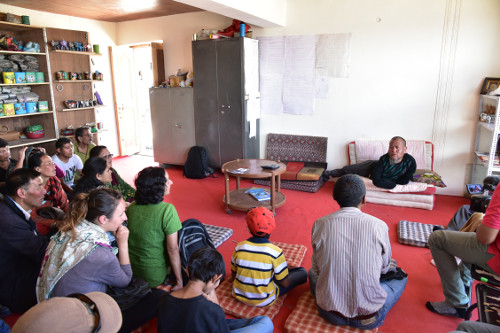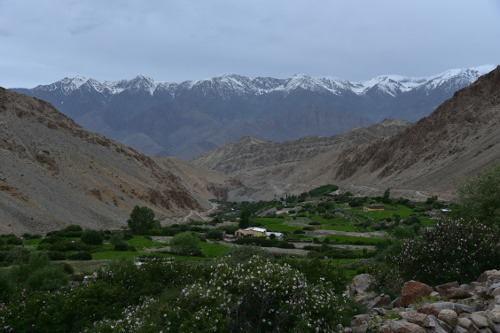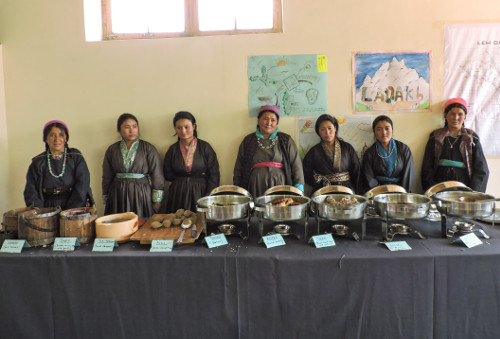“When it rains heavily or there are strong winds, the rubbish comes into our village,” said the Sarpanch, pointing to a spot in the hills above Sabo village where all the garbage of Leh town is dumped. “There is also danger from the packs of feral dogs that have made the dump their home. Why can’t Leh deal with its waste more responsibly?”
Why indeed. As I heard Sarpanch Rinchen’s lament, it struck me that this was a far cry from tourism advertisements that portrayed Ladakh as ‘idyllic’. This thought was amplified when I heard Sonam Wangchuk, well-known educationist and activist of the region, describe Ladakh as ‘the world’s highest garbage dump’, an ironic twist to the advertisements proclaiming it as having the highest motorable road, the highest pass, and many other ‘highs’.
I was in Ladakh for a couple of weeks in July this year with my colleagues Sujatha Padmanabhan and Rashi Mishra, to participate in a gathering of groups and individuals working on solving the region’s many problems. Called Vikalp Sangam (‘Alternatives Confluence’), this gathering was organized in Leh during 20-24 July by the local groups Ladakh Ecological Development Group (LEDEG), Snow Leopard Conservancy India Trust (SLC-IT), Students’ Educational Cultural Movement of Ladakh (SECMOL), and Ladakh Arts and Media Organisation (LAMO), and the Pune/Delhi based NGO Kalpavriksh.

Vikalp Sangam participants with Mehmet Iqbal at PAGIR. Pic: Ashish Kothari
This was part of a nation-wide series of confluences that began in 2014. The Leh Sangam focused on how Ladakh was going through some rapid changes after having been opened up for mainstream ‘development’ and tourism, especially in the last couple of decades.
‘Development’ hits Ladakh
Ladakh is mostly comprised of high altitude desert and mountain ecosystems. It is a harsh environment in which nomadic pastoral and farming peoples have thrived, finding ways to use natural resources in ways that do not degrade them. Wildlife and people have co-existed for centuries, though of late distortions have crept in. Buddhism and Islam predominate, with an enormous cultural diversity as displayed in art and craft forms, cuisines, language, lifestyles, and knowledge.
Such an ecologically and culturally unique context requires a ‘development’ strategy that is finely tuned to local peculiarities. Unfortunately, much of development thinking here has been dictated by New Delhi and Srinagar. Perhaps the one with the most impact has been mass tourism. With revenues being a major attraction, little thought has been devoted to regulating tourist numbers and infrastructure.
Till very recently, however, typical tourist circuits had not included Ladakh. That is, till the Aamir Khan film 3 Idiots in 2010 when viewers saw the incredible Pangong Tso (Lake) in the film, and suddenly, tourist numbers more than doubled to over 1.5 lakh per year.
Tour operators offered packages promising clients a visit to where Khan in his role as Phunsuk Wangdu (partly inspired by Sonam Wangchuk of SECMOL!) presumably stood or walked, or where certain parts of the film were shot. Several ‘3 Idiots’ cafes have come up near the lake, and many luxury camping sites, mostly run by outsiders.
All of this has entailed significantly enhanced vehicular traffic and consequent pollution and disturbance, by visitors who care little about what they are leaving behind as long as they have their “I-stood-where-Aamir-stood” selfie. It also means serious disturbance of wildlife. There is a cultural invasion with less visible immediate impacts, but quite likely long-term effects that could be disastrous for Ladakh’s own cultures.
Development has also meant Ladakh’s entry into the ‘garb-age’. A study in 2011 showed that around 30,000 plastic water bottles were being dumped every day in Leh town! This and other non-biodegradable waste can be seen carelessly strewn around, and when it is taken away, it ends up at ‘Bomgard’ dump above Sabo village.
Leh town is also experiencing traffic jams and accidents, and pollution and dust levels high enough to cause respiratory problems in children. There has been an explosion in construction, as every second person seems to be setting up a guest house or a hotel, and many have been switching from traditional materials to cement and concrete, necessarily brought from outside and ruining the aesthetic beauty of the town.
Several offer flush toilets, using precious water and causing pollution to water sources, even though dry toilets work very well in Ladakh’s conditions. Public transport is very poor, and private vehicles now rule the streets.
A special concern expressed at the Sangam was the transformation of food habits, especially amongst the youth, from the nutritious traditional foods to fast foods and junk. That bane of every Indian settlement now, plastic packets and sachets with chips and other snacks and supari and pan masala and so on, can be seen all over not only in Leh but also in shops deep into the rural interiors of Ladakh.
Signs of hope
While the problems that Ladakh is facing were brought out at the Sangam, its main focus was on solutions and alternatives. For the groups that put it together, the main quest was: what kind of ‘development’ or well-being pathways could Ladakh adopt that could help retain its ecological and cultural ethos while meeting the legitimate needs of its population, including decent livelihoods and employment? What initiatives already exist, that could provide lessons and models for such a process? Where are the sources of hope?
And so participants at the Sangam also discussed the quiet work of sustaining, reviving, or reconstructing Ladakhi society. Traditional and new forms of livelihoods and employment are being attempted by many groups. Traditional crafts like pashmina shawls and carpets are being supplemented with new occupations like community-based ecotourism.
The Ladakh Arts and Media Organisation (LAMO) promotes an alternative vision for the arts and media, including through exhibitions, performances and workshops. Rural homestays have become quite common; where they are well-managed, they are the best option for visitation that is meaningful to both local people and visitors, and which is ecologically sustainable.
On the trip we had wonderful experiences at homestays in Hanle and Saspotse villages, getting a feel of Ladakhi family life and eating local dishes prepared with warm hospitality. We were also excited to meet members of the Ladakhi Women’s Travel Company, a professional trek-organising body run entirely by women.

Saspotse Village, Ladakh. Pic: Ashish Kothari
Women’s empowerment and justice for the unprivileged are also part of NGO or official initiatives, such as those of the Women’s Alliance of Ladakh. Particularly inspiring for the Sangam participants was a visit to the People’s Action Group for Inclusion and Rights (PAGIR), an organization of disabled people working on advocacy for dignified inclusion of the disabled in all aspects of Ladakhi society, and creating ecologically relevant livelihood options such as making products from waste materials.
A number of technological innovations are providing some amazing solutions, for example to the problem of heating energy and sturdy housing. With over 300 days of bright sunshine, Ladakh is the ideal location for solar energy. The Ladakh Ecological Development Group (LEDeG), one of the oldest NGOs, has worked extensively on this. A particularly exciting innovation in Ladakh is passive solar construction, which keeps the house warm even in -30 degrees cold, with no electricity needed.
Another is the ‘ice stupa’, an ingenious method of freezing water in a high conical mound in winter, the melt from which could provide settlements with adequate water in the long dry seasons. The Ladakh Environment and Health Organisation (LEHO) has worked on driers, looms, dyeing and other technologies to enhance livelihood opportunities.
The concern regarding food, mentioned above, has been a catalyst in a number of initiatives to promote Ladakhi foods. Dzomsa and Ladakh Fine Foods in Leh market, promote organic, wholesome foods and ecofriendly products (http://ladakhecoguide.com/city/dzomsa/;www.ladakhfinefoods.com). They also provide tourists and residents the option of refilling water bottles rather than buying new ones. Increasingly Leh’s shops are veering towards providing ecofriendly products, perhaps finding that these are favoured by many tourists (especially foreigners).

Ledo village women's group with their traditional food. Pic: Ashish Kothari
The water refilling option is just one of several that are promising to tackle the enormous waste problem. Leh was perhaps India’s first town to effectively ban polythene carry-bags, the Hill Council’s policy action being acted upon by determined members of the Women’s Alliance of Ladakh, who repeatedly marched in the streets or periodically checked shops to ensure its implementation!
With inappropriate education (that adds to unemployment as a major driver of the youth out of Ladakh) being a serious concern, some alternative learning initiatives are showing the way to a different model. The Students’ Educational Cultural Movement of Ladakh (SECMOL) is a learning institution meant for 10th grade dropouts, providing them with vocational and conceptual orientation that helps build the confidence and capacity to face life and find meaningful occupations. Its campus, located on the banks of the Indus outside Leh, is 100 percent self-reliant in energy, produces much of its own food (organically), reuses or recycles most of its waste.
Creating ecological and social awareness is necessary also amongst adults, especially as notions of consumerism and an alien mode of ‘the good life’ swamp the region. Alternative media is playing its role in this. Stawa and Ladakh Phoniya are magazines brought out by civil society; Himalayan Film House, started by Stanzin Dorjai (himself a product of SECMOL), is producing some very telling films on aspects like climate change and the environment.
Then there are the groups acting to revive human-wildlife harmony where it has been disturbed. The Snow Leopard Conservancy – India Trust and the Nature Conservation Foundation have successfully stopped or reduced retaliatory killings of Snow leopards and wolves, by devising safer livestock holding conditions and facilitating alternative livelihoods like tourism homestays (see for instance, http://www.vikalpsangam.org/article/protecting-snow-leopards-with-local-communities/).
SLC-IT and Kalpavriksh have also produced conservation education handbooks that make teaching much more locally relevant than the textbooks coming from outside Ladakh.
The Sangam also had participation of groups from outside, who were able to give examples of initiatives elsewhere, that may be of relevance to Ladakh: the zero-waste trekking model pioneered by the Khangchendzonga Conservation Committee in Sikkim, the use of national laws on waste and toxics as described by Toxics Link, and several examples of food, water, and other sustainability and justice initiatives around the country described by Kalpavriksh.
A futuristic vision
Another major source of hope brought out at the Sangam was a Vision Document for Leh district that was actually prepared a decade back. This document is exceptional in being one of the few such exercises done at a district level in India; even more important, it is one of the few that has an integrated ecological, economic, and cultural perspective.
It admits that, “somewhere along the way, the importance of social and cultural values has been forgotten. Ladakh is not an exception to this development. Though connected to the outside world barely for forty years, it has already shed much of its traditional wisdom and cultural heritage … the rapid decline that this region’s resources – natural, and also social & cultural – have witnessed in the recent past … the need of the hour is to bring an immediate stop to the shocking deterioration of our rich heritage by developing an appropriate set of preventive measures.”
It emphasizes ecological sustainability as a central principle, local skill-based employment generation (e.g. through crafts, and homestay based tourism) rather than big industrialisation, educational reform to make schooling and college more culturally rooted and relevant, decentralized renewable energy rather than big conventional power plants, and urgent tackling of the waste problem. It states that the “cottage industries sector … is a mine of untapped potential … (with) the promise to generate all the jobs that Ladakh’s unemployed youth need.”
When completed, the Vision Document was endorsed by the Ladakh Autonomous Hill Development Council (LAHDC) and the J&K government, and released by the then Prime Minister Manmohan Singh. In a note prefacing the Vision Document, the Chief Executive Councillor of the LAHDC stressed the need to “make sure that progress in Ladakh means the overall well-being of humans and nature and not just a blind rush for material development”.
Many people in Ladakh had high expectations when the Vision Document came out. Like many such visionary exercises in India, however, the document appears to have remained largely unimplemented. Tsewang Rigzin, an active Councillor and a participant of the Vikalp Sangam, said there were perhaps several factors leading to this failure.
Amongst these was the fact that the LAHDC was autonomous only on paper. It has little effective financial and legal power relative to the J&K government, and departmental priorities are set elsewhere. Additionally a time-bound specific action plan did not really emerge from the document.
This makes me wonder if it was a serious historical mistake to club Ladakh into J&K, despite the enormous differences between it and the rest of the state. It also reminded me of another exercise in Ladakh, the state level Biodiversity Strategy and Action Plan carried out under a national process that we coordinated for the Union Ministry of Environment and Forests, in the early 2000s. That Action Plan too was never implemented.
Interestingly Sonam Dawa, who coordinated it, was also convenor of the group to formulate the Vision Document. Dawa was a quiet participant at the Sangam, but I can imagine the disquiet in his heart and mind at seeing such serious effort going largely abegging.
The Sangam’s recommendations
With both the problematique and the solution-based initiatives having been discussed, the Sangam focused on pathways for the future. An overall recommendation was to revive the Vision Document, with a review for missing or weak elements, and updating and modification as required for new circumstances. Most importantly, however, there was a strong recommendation for its urgent implementation.
Additional recommendations include:
- Greater recognition and support to land-based occupations, including encouragement to self-reliant occupations by improving local demand and marketing, value added & processed products (e.g. apricot juice and dried fruits), incorporating local foods into PDS, shifting subsidies of chemical fertilisers to organic farming, declaring a target to convert all of Ladakh into an organic, GMO-free region, regenerating the health of land and livestock, encouraging local livestock and seed varieties;
- Judicious use of water, including discouragement of flush toilets, water-saving irrigation techniques, and full reuse and recycling;
- Regulation of tourism numbers and activities, no further tourism infrastructure in Leh, promotion of homestays and local operators, penalties for violation of tourism ethics;
- Regulation of and mass awareness regarding the danger of junk foods, and promotion of local foods e.g. by inviting village cooks to make meals for LAHDC meetings;
- Encouragement of traditional Amchi health system and awareness regarding dangers of drugs;
- Provision of appropriate infrastructure to villages to enable people to stay back with full facilities, including proper public transport connections and multi-media centres;
- Regulation of and awareness generation regarding excessive packaging, encouragement of ecofriendly products as religious offerings, and ensuring that the Army deals with its waste on site;
- Empowerment of gram sabhas including devolution of financial powers, facilitation of women’s participation in all governance institutions, and considering a stronger role for traditional governance systems (like goba) in relation to the panchayat system;
- A comprehensive plan for Leh to ensure that it is ecologically sustainable and enables equitable access including to the differently abled, encouraging public transport and discouraging private cars, providing safe cycle and walking paths;
- Full social inclusion of the differently-abled, including in government offices and schemes;
- Introduction of alternative pedagogic systems into all schools & colleges, including vocational and practical skills, promotion of alternative schools or learning centres in each school such as SECMOL, and encouragement of village experts as teachers;
- Wide consultation on whether parts or all of Ladakh could be declared a World Heritage Site for both its natural and cultural features, and ensuring that Ladakhi people are driving it from the start.
There also needs to be serious discussion on how Ladakh could be rendered truly autonomous, rather than governed by remote control from Srinagar and Delhi.
The above recommendations from the Vikalp Sangam may appear to be ambitious, but given that several groups are already showing the way through practical demonstration, they are certainly not unfeasible. If the rest of India could recognize and support the region’s uniqueness and ability to work out its own sustainable pathways, there is every possibility of Ladakh regaining the harmony between humans and nature it once had, and achieving social equity amidst cultural diversity.
























